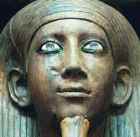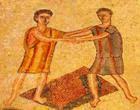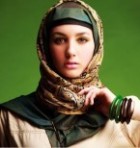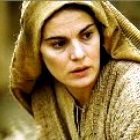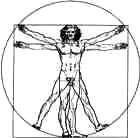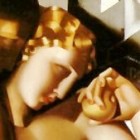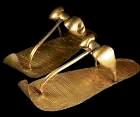Why do we wear clothes?
Bible Study Resource
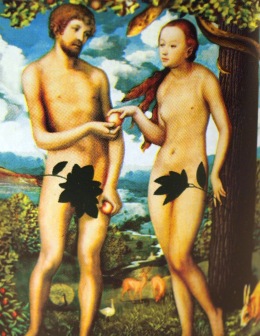 Ever since Adam, first man and Eve, great mother used fig leaves to cover their nakedness, people have worn clothes. Why? Clothes
Ever since Adam, first man and Eve, great mother used fig leaves to cover their nakedness, people have worn clothes. Why? Clothes
- give protection from the weather
- identify the wearer
- proclaim his status and style
- or even act as a magic charm (Numbers 15:38).
Clothing is also, of course, decoration. For many people, this might be its most important function. Are you one of them?
What about clothes in the ancient world?
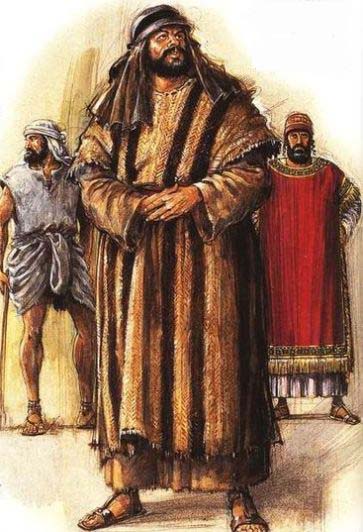
Workman, middle management, rich man!
No clothes have survived from ancient Israel, so we can’t say for certain what they wore. But we can make an educated guess by looking at clothes in neighboring countries like Assyria and Egypt.
Of course, if we do that, we have to take into account the fact that ancient Israel was much lower in the pecking order than these two mighty empires. Assyria and Egypt were centers of fashion. Israel was just a dusty little province.
Where do we get our information?
Mainly from wall reliefs and paintings showing ancient clothing. Of course these are ‘special event’ pictures, and do not show what people wore every day. But fashion and fabrics did not change as quickly as they do in the modern world, so we can make an educated guess about clothing in the ancient world.
We can also look at what fibres were available for weaving, and dyes for colouring.
Joseph’s Coat
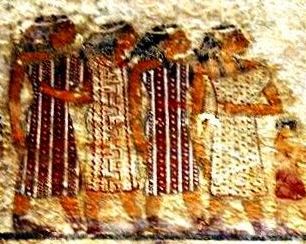
Detail of the Beni Hassan mural showing striped, multi-coloured clothing on Asiatic merchants
What did it look like? Of course there is no picture of that famous ‘coat of many colours’ that angered Joseph’s brothers so much (Genesis 37:23).
So what was it like?
- The Revised Standard Version of the Bible describes the garment he wore as a ‘long robe with sleeves’. Many scholars believe it was a tunic or robe made of a material woven from different coloured threads, similar to the fabric in the Egyptian Beni-Hassan painting shown at right, in which some of the tunics are made of vertical strips of woven or embroidered material in bright colours, blue and red predominating (see the detail from the Beni Hassan mural above).
-
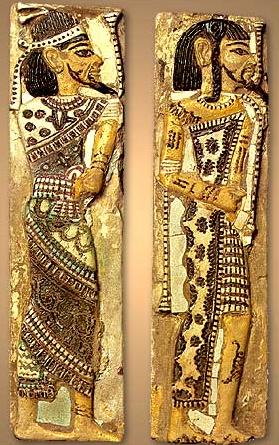
Medinet Habu tiles of ‘Asiatics’ in ornate clothing
Other scholars are of the opinion that Joseph’s ‘coat’ may have been a long-sleeved tunic reaching to the ankles (see a very luxurious example of this type of garment, from one of the tiles discovered at Medinet Habu, at right). Of course Joseph, being the son of a mere tribal leader, would have had a much more modest garment, but you can see that the design would have made hard work impossible – especially for shepherds like Joseph and his brothers, who needed to be agile.
- The garment may also have denoted high social rank, which would be an added thorn in the side for Joseph’s brothers.
The implication was that Joseph was being singled out by his father to work as an overseer, which meant favouritism as far as his older brothers were concerned, and kindled the flame of intense dislike they already felt for their precocious younger brother.
Hebrew Travellers, Beni Hasan
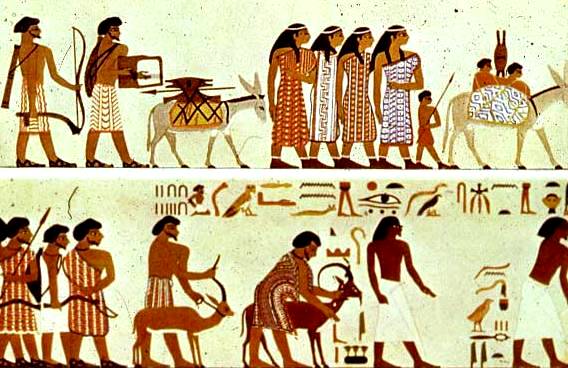
Above: drawing of the mural from Beni Hasan in Egypt, circa 1890BC, shows a band of nomadic merchants from Syria-Canaan, bringing stibium (a cosmetic for painting the eyes). The caption in front of the leader identifies them as being from a foreign country called ‘Ibsha’.
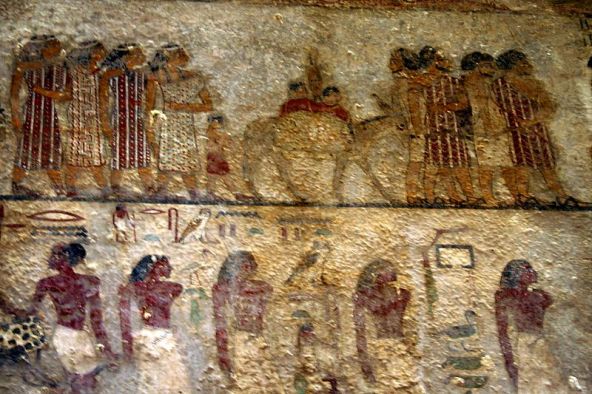
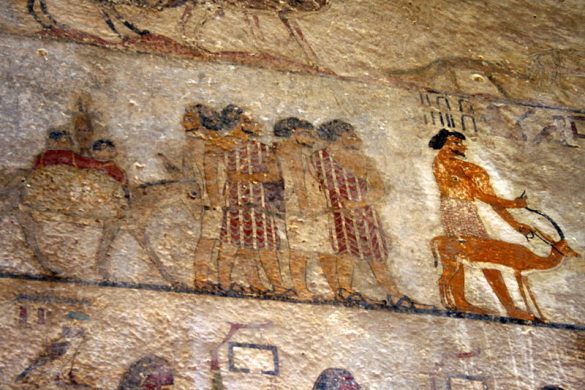
Photographs of the mural. For more information, see ARCHAEOLOGY: WHO WAS ABRAHAM
An Egyptian wall painting (above) of the 12th dynasty shows merchants coming from the east, bringing the dye used to make kohl, the eye-liner used by Egyptians to beautify their eyes and protect against dusty winds and eye infections.
The merchants are wearing knee-length multi-colored tunics. The fabric seems to be woven in strips of various colors. Others wear what looks like a kilt reaching from waist to knee.
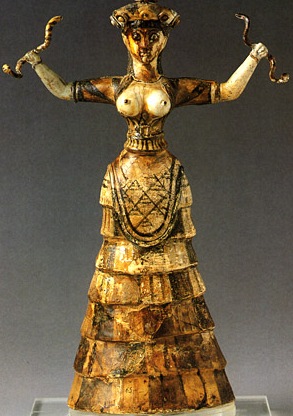
Reproduction of the Minoan Snake Goddess, showing multi-colored fabric used in the skirt of her costume
The men have short beards, and both men and women have well-groomed hair. The men wear dark-colored leather sandals. The women wear ankle-length boots – and is that the edge of a fine woolen sock peeping out from the top of the boot? The women’s hair is combed, then twisted into ringlets and kept in place with a white, probably linen, band.
The Minoan Snake Goddess, shown at right, wears striped fabric similar to that worn by the Hebrew merchants in the Egyptian wall paintings above.
The Black Obelisk
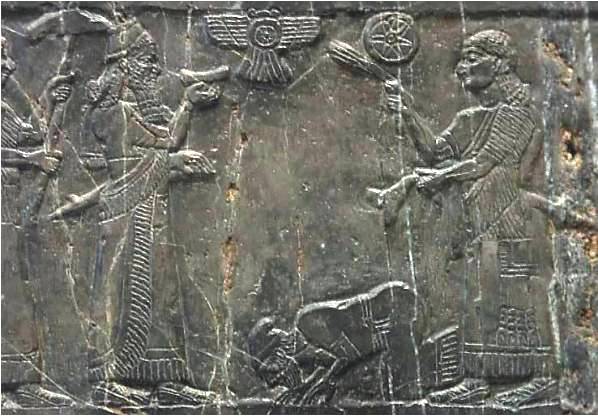
The king of Israel prostrates himself before the Assyrian king – this was the normal position for a subordinate, especially a conquered foreign king like Jehu of Israel. This panel is taken from the Obelisk of Shalmaneser III, which shows Jehu prostrating himself before the Assyrian king. Jehu appears in 1 Kings 22:29-40, and 2 Kings 9:21-37 as the leader of a palace coup in which Queen Jezebel and her entire family were murdered; see JEZEBEL for the story).
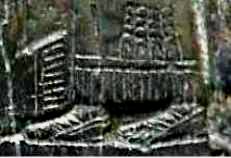 Notice the shoes of the Assyrian men (right), with leather covering at the sides to protect the instep and heel.
Notice the shoes of the Assyrian men (right), with leather covering at the sides to protect the instep and heel.
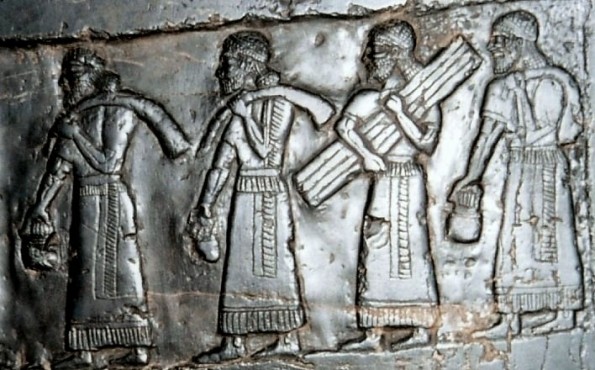
Israelites bring tribute to Shalmaneser III, scene from one panel of the Black Obelisk. Fringed garments were common for the well-to-do. Women wore a more richly decorated version.
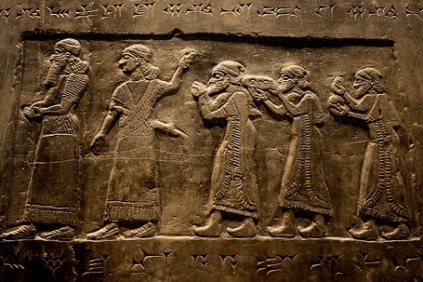
Israelites bring tribute to Shalmaneser III, scene from one panel of the Black Obelisk, photograph by Tewkes. The obelisk shows Israelites laden with gifts for the Assyrian king. These men wore the same peaked cap that the Israelite king Jehu wears; this cap seems to show the Israelites in the procession. All the Israelites are bearded. They wear a long robe with fringes round the hem and a girdle, a long cloak with fringed end thrown over the shoulder, and pointed shoes.
Bible references to clothes
Mixed materials in one piece of clothing forbidden, Deut. 22:11.
Men forbidden to wear women’s clothes, women forbidden to wear men’s clothes, Deut. 22:5.
Rules with respect to women’s clothes, 1 Tim. 2:9,10; 1 Pet. 3:3.
Not to be held overnight as a pledge for debt, Ex. 22:26.
Ceremonial purification of, Lev. 11:32; 13:47-59; Num. 31:20.
Various articles of clothing: Mantle, Ezra 9:3; 1 Kin. 19:13; 1 Chr. 15:27; Job 1:20; many colored, 2 Sam. 13:18; purple, John 19:2,5. Robe, Ex. 28:4; 1 Sam. 18:4. Shawls, Isa. 3:22, Embroidered coat, Ex. 28:4,40; 1 Sam. 2:19; Dan. 3:21. Sleeveless shirt, Matt. 5:40; Luke 6:29; John 19:23; Acts 9:39. Cloak, 2 Tim. 4:13; John 19:2,5. Skirts, Ezek. 5:3. Mufflers, Isa. 3:19. Sashes, Isa. 3:20.
Changes of raiment, the folly of excess, Job 27:16.
Uniform vestments kept in store for worshipers of Baal, 2 Kin. 10:22,23; Zeph. 1:8;
for wedding feasts, Matt. 22:11.
Gifts made of changes of clothes, Gen. 45:22; 1 Sam. 18:4; 2 Kin. 5:5; Esth. 6:8; Dan. 5:7.
Search Box
![]()
© Copyright 2006
Elizabeth Fletcher

